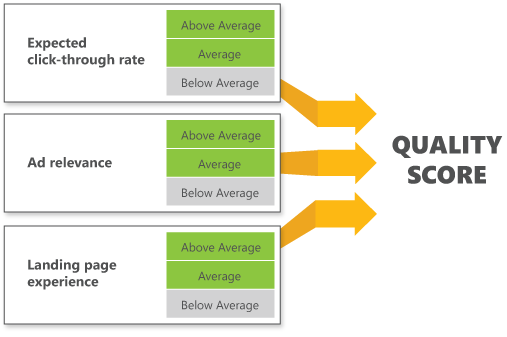Poor Landing Page Relevance in Bing Ads – Nows days bing create a problem with tech support ads… showing low ads relevance message.
Question is? How to fix this issues….
Table of Contents
Bing Ads Quality Score
- The Bing Ads quality score is based on customers’ search queries and other input that matched keywords exactly in the last 30 days. In international markets, you may see a decrease in quality score coverage for phrase match and broad match keywords. Bing Ads is working to improve the quality score coverage to international markets and will update this topic when available.
- Traffic in the content network and the Bing, AOL, and Yahoo syndicated search partner sites are not included when calculating your quality score.
- The quality score is usually updated between 14 to 18 hours after the end of the day in UTC time (Universal time, formerly GMT or Greenwich Mean Time). For example, if you live in the U.S. Eastern time zone, your quality scores would update 14 to 18 hours after midnight local time (5 a.m. Universal Time), or between 2 and 6 p.m. the next day.
- If you want to learn more about impression share, see Find out your impression share with the share of voice report.
Keyword Relevance
Choosing relevant keywords is the simplest way to give your Bing Ads Quality Score a boost. Here are a few easy tips for selecting the most relevant keywords possible:
- Make sure keywords match ad copy – This is best accomplished by creating smaller, tighter ad groups. The more often you have specific keywords appearing in your ads, the better.
- Stick to Phrase and Exact Match – Broad match keywords may help your ad appear on a wider variety of searches, but it will almost certainly affect your Quality Score on Bing.
- Increase Exact Match Keyword Bids 10-20% Over Phrase Match – By bidding more for exact match keywords than phrase match keywords (for the same keywords, that is), you increase the likelihood that your exact match keywords will show.
Landing Page Relevance
A lower Quality Score leads directly to higher CPC and a lower Share of Voice…
As part of your overall Bing Quality Score, you also receive a Landing Page Relevance Score. As you would expect, this score tells you how closely related your landing page and ads are to a person’s search terms and your ad copy. While not quite as simple as increasing your keyword relevance, there are several ways to improve the relevance of your landing page:
- Lower your landing page bounce rate – An easy way to do this is including links to other parts of your site. Sure, you may see a slight drop in conversion rate, but you’ll also see a higher Quality Score and lower CPCs.
- Write relevant meta title, keyword, and description tags – Google doesn’t take these into account when factoring in Quality Score on AdWords, but they absolutely play a role in your Bing Quality Score.
- Add text content with targeted keywords – You can do this in any number of ways. For instance, rather than simply listing a product on your landing page, include a keyword-rich product description along with it. You can do the same with reviews, testimonials, etc.
Landing Page User Experience
Even if your landing page is highly relevant, Bing will dock your score if the user experience isn’t up to par. Often times, a high bounce rate will indicate a poor user experience. While there are several ways to enhance a user’s experience, you should focus on these:
- Improve page load times – If your page takes too long to load, many potential customers may quickly lose interest in your site. Bing understandably considers this a negative user experience.
- Eliminate Popups – There may be no quicker way to annoy a user than bombarding them with popups. If you’re looking to enhance your landing page’s user experience, get rid of your popups.
- Don’t Auto-Play Videos – We’ve tested auto-playing videos on several landing pages over the years, and the results are never good. Videos are great features for a landing page, but you should let users click play whenever they’re ready.
Quality score in depth
The Bing Ads quality score shows you how competitive your ads are in the marketplace by measuring how relevant your keywords, ads, and landing pages are to customers’ search queries and other input.
The quality score can range from 1 to 10, with 10 being the highest. You can see the quality score on the Keywords,Campaigns, and Ad Groups tabs on the Campaigns page.
Use your quality score to help determine where to focus your optimization efforts and improve your ROI.
Relevance and quality policies
Advertisers and consumers both benefit when they have positive experiences with Bing Ads. To achieve this, please follow the policies about relevance and quality on this page. These requirements focus on four core aspects of your campaign that affect user experience: keyword relevancy, ad copy, landing page and site user experience, and landing page and site content quality.
How does this policy affect your ad delivery?
- Advertisers with more relevant keywords and higher quality ads and landing pages are usually rewarded with more prominent ad positions or a lower cost-per-click (CPC).
- Less relevant keywords and low-quality ads and landing pages might result in less favorable ad positions or a higher CPC.
- In some cases, the ad might not appear at all. Please check the Marketplace Exclusion section below for scenarios in which ads or sites may be completely excluded from the marketplace.
Keyword relevancy
Using the right techniques in choosing keywords and building ads not only drives user engagement, but it also helps maintain the ROI of the marketplace for all advertisers.
Keywords should be relevant. This means your site should be a satisfactory destination for users, based on a primary user intent of the keyword(s) you select.
Your keywords should relate directly to either:
- The specific range of products, services, or content on your landing page.
- The general content, purpose, and theme of your site.
Please note: Extremely popular or trending queries may be subject to a higher standard of relevancy and ads must fully align with the primary user intent of the keywords/queries to participate.
Ad copy (title, text, and display URL)
Ads must:
- Be clear, truthful and accurate: Clearly and accurately demonstrate in your ad how your keywords relate to the product or service you offer.
- Be correctly constructed: Ads should be grammatically correct, not include misspellings, and be formatted correctly.
- Manage expectations:
- Ads should not mislead.
- Ads must be highly relevant to the product, services or information presented on your landing page, or the general content, purpose, and theme of
your site. - When an ad implies that a product is for sale, the landing page must allow the purchase of that product.

For information about how to format and create your ads, please see our Ad content and style policies.
Marketplace exclusion
Sites may be excluded if there is reason to believe that their advertising or business practices are potentially malicious, harmful or deceptive or they consistently violate Microsoft’s policies. For more information, please see the User safety and privacy policies.
The following are examples of sites that may be completely excluded from the marketplace:
- Sites that include viruses, malware, spyware, or other self-installing programs.
- Business models that attempt to mislead site visitors, or that seem deceptive or fraudulent.
- Phishing sites that try to trick visitors into sharing personal data for fraudulent purposes, such as stealing one’s identity.
- Pages that consist entirely of advertising, or whose main purpose is to direct site visitors to advertising.
- Link farms.
- Parked domains.
- Sites operated by advertisers who consistently violate our Bing Ads policies or submit large numbers of irrelevant keywords.
Landing page and site user experience
The functionality of your site should not surprise site visitors or interfere with a user’s ability to navigate. Navigation buttons should operate in a standard and predictable manner, and sites and all parts of the page content should load properly.
Landing page behavior may provide a low-value user experience if they:
- Redirect site visitors unexpectedly to unrelated domains.
Low-value user experience:
 Higher-value user experience:
Higher-value user experience:

- Use doorway pages, or cloaking.
- Without the users consent:
- Change browser preferences or resetting default home pages.
- Resize browser windows or disabling browser buttons.
- Spawn multiple pop-ups or pop-ups that prevent visitors from leaving the site.

- Do not open properly or consistently result in a “product not available” message.
Here’s what the numbers mean:
| Quality Score | Description |
|---|---|
| 1-5 | The keyword is underperforming in the marketplace – so your ads are less likely to appear on the Bing Network when that keyword is matched. If one or more of the three components of quality score are Below Average, most likely your score will be 5 or below. If you want to improve your quality score, you need to make changes to improve the poor performing component. |
| 6 | The keyword is competitive – but no better than average compared to other keywords targeting the same traffic. If all three components are Average, or a combination of Average and Above Average, most likely your score will be 6 or higher. If you want to improve your quality score, you need to make changes to get all three components to Above Average. |
| 7-10 | The keyword is very competitive in the marketplace, and its CTR is higher than the average CTR of keywords targeting the same traffic. If all three components are Above Average, most likely your score will be 7 or above. |
The quality score has three components, and each in turn has a score.

Expected click-through rate score. Reflects how likely your ads will be clicked and how well your keyword competes against other keywords targeting the same traffic. This score predicts whether your keyword is likely to lead to a click on your ads, taking into account how well your keyword has performed in the past relative to your ad’s position.
Here are some ideas to improve the score:
| What to do | How to do it |
|---|---|
| Improve your click-through rate (CTR) | There are several ways to potentially improve your CTR, such as improving your ad copy, properly organizing your campaign, and improving your ad position. For details on each of these options and more, see How do I improve my ad campaign performance? |
| Make sure your ad grabs the attention of your audience | Speak to your customers, use their language, and be specific about what you are offering. For more suggestions, see What makes an effective ad? |
| Remove underperforming ads and keywords | Track how ads and keywords are performing using performance reports every two to four weeks. Delete ads and keywords that have a low click-through rates, especially if they also do not have a good conversion rate. For details on using reports, see Create a report. |
| Add relevant keywords | Use the Bing Ads keyword research tools to identify new keywords that are relevant to your site content. You’ll find the Research Keyword tool on the Bing Ads Tools menu. You can alsodownload and install the Bing Ads Intelligence add-in for Microsoft Excel. |
Ad relevance score. Indicates how relevant your ad and landing page are to the customer’s search query or other input.
Here are some ideas to improve the score:
| What to do | How to do it |
|---|---|
| Keep related keywords and ads together | Group related keywords and ads into their own ad groups, and then create a unique landing page for each group of ads and keywords. For example, if you’re a tea retailer you could have separate ad groups with keywords and ads for green tea, black tea, and herbal tea. |
| Make sure your ad is relevant | Ads that are relevant to searchers’ queries or other input are more likely to have a higher click-through rate and, therefore, a greater positive effect on your quality score. For example, write an ad for green teas that includes appropriate keywords (green tea, sancha, dragonwell) and that sends your customers to a landing page optimized for those keywords. For more information, see About improving ad relevance. |
| Give customers an overview | Create a landing page that gives potential customers an overview of your products or services (for example, the different types of tea you sell). |
| One landing page per product | If your business sells different products or offers a suite of services, create individual landing pages for each of your products or services (such as green teas, black teas, and herbal teas). Then be sure to use these landing page URLs for your destination URLs. For more information on how to do this, see Send your customers to a specific landing page. |
Landing page experience score. Describes whether your landing page is likely to provide a good experience to customers who click your ad and land on your website.
Here are some ideas to improve the score:
| What to do | Why and how to do it |
|---|---|
| Make sure your lading page loads quickly | If a potential customer thinks your website is down because it is taking too long to load, they are more likely to leave your website. Make sure your landing page loads quickly once someone clicks on your ad from any device. |
| Improve your website quality | If your website is slow and difficult to understand, your potential customers will go elsewhere. Make sure your landing page is easy to read. Try reducing the number of graphic images, for example, or taking other appropriate measures to help it load faster. |
| Link your destination URLs to the correct webpages | Customers aren’t pleased if they click your ad title and end up on a page unrelated to the ad content. So if your ad is selling green teas, users should land on a page about green teas instead of one about teapots. |
| Keep advertising links on your webpages to a minimum | Websites whose content includes a large amount of advertising, without offering any other significant value to site visitors, are not attractive to customers. Instead, focus your content on what potential customers really want to know about – your services or products. |
| Use original, in-depth content | Landing pages with original content (not copied from other sites) can improve your quality score and landing page user experience score, and may help improve your conversion rates. You can find more at Understanding Quality Guidelines for Bing Ads. |



 If you'd like us to dramatically improve your website & business, visit our "
If you'd like us to dramatically improve your website & business, visit our "